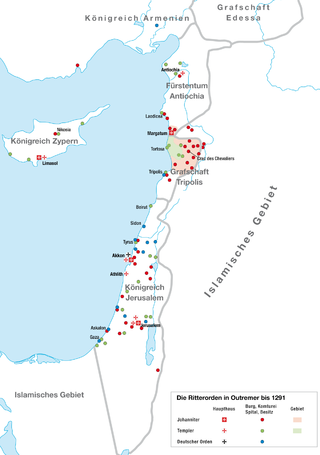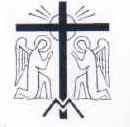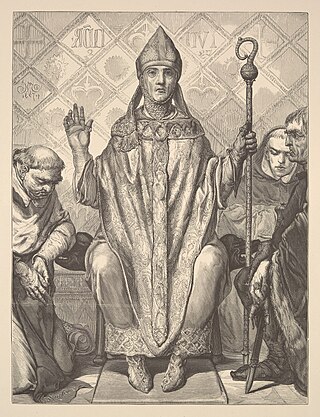The Crosiers [1] or Brethren of the Cross [2] [3] or crutched friars [4] is a general name for several loosely related Catholic orders, mostly canons regular. [4] Their names derive from their devotion to the Holy Cross. They were founded in the 12th and 13th centuries, during the era of the crusades in the Holy Land. [2] These orders tended to maintain hospitals and care for the sick. [5] Currently, the term "crosiers" most frequently refers to the Canons Regular of the Order of the Holy Cross originating from Belgium, but it could also refer to at least five other orders from Jerusalem, Portugal, Italy, Bohemia, Poland–Lithuania, and a group of friars in England and Ireland.
The Canons Regular of the Holy Sepulchre in Jerusalem were sometimes referred to as crosiers with the double red cross. [1] [6] The order was founded in 1114 to care for the Church of the Holy Sepulchre built where Jesus was crucified. The male order was suppressed by Pope Innocent VIII in 1489 though the female order continues to exist. [7]
The Portuguese Canons Regular of the Holy Cross of Coimbra (Ordo Canonicorum Regularium Sanctae Crucis, ORC) was founded by Saint Theotonius in Coimbra in 1132. [2] The order was closed during the brief reign of Pedro IV in 1834, but restored in 1979. [8] The order's mother house is the Monastery of Santa Cruz in Coimbra. It maintains presence in Europe (Germany, Austria, Holland, Italy, Portugal and Switzerland), in the Americas (Brazil, United States and Mexico), and in Asia (Philippines and India). [8]
The Italian Order of the Crociferi (Ordo Cruciferorum; Fratres Cruciferi) was established between 1160 and 1170 by Pope Alexander III. [9] It became popular in Italy and had 208 monasteries divided into five provinces. [5] They wore a blue habit and carried a silver cross. The order was abolished by Pope Alexander VII in 1656. [10]
The Belgian or Flemish Canons Regular of the Order of the Holy Cross (Ordo Sanctae Crucis, OSC) is traditionally said to be founded by canon Theodore of Celles in Huy in 1210. [2] The order was confirmed by Pope Innocent IV in 1248. [4] Many monasteries were closed during the French Revolution and the Napoleonic Wars, but the order was revived. [4] Its superior general is based at San Giorgio in Velabro in Rome. As well as surviving in Belgium and the Netherlands, it today maintains a presence in Germany, Austria, United States, Brazil, the Congo, and Indonesia. [11]
The Bohemian Knights of the Cross with the Red Star (Ordo Militaris Crucigerorum cum Rubea Stella, OMCRS) was founded in 1233 by Agnes of Bohemia. [12] Unlike the other orders, this is a military order dedicated to the protection and care of the sick, [2] and was made an independent hospitaller order by Pope Gregory IX in 1237. [12] They spread into Moravia, Silesia, Hungary, and Poland. It is believed they had three houses in Scotland. [5] The order is currently active in the Czech Republic and Austria (Vienna). [13]
The origin of the Polish–Lithuanian Canons Regular of the Penitence of the Blessed Martyrs (Ordo Canonicorum Regularium Mendicantium S. Mariae de Metro de Poenitentia Sanctorum Martyrum) is unknown. When it was first mentioned in 1256, it already had three monasteries. [6] Originating from Rome, it was most popular in the Kingdom of Poland and the Grand Duchy of Lithuania. It was suppressed by the Russian Empire in 1832 and the last monastery closed in 1845. [14] The Bohemian Order of the Holy Cross with the Red Heart (Canonicus Ordo Crucigerorum cum Rubeo Corde) separated from the Canons Regular of Penance of the Blessed Martyrs and became an independent order in 1628. [6] This order was closed in 1783 due to Josephinism reforms introduced by Joseph II, Holy Roman Emperor. [15]
The first Friars of the Cross or the Crutched Friars (also crossed or crouched friars) [10] arrived to England sometime between 1230 and 1244. [16] At least five of the Orders of the Holy Cross established some presence in England creating a great confusion as to which order they properly belonged. [5] The Crutched Friars are sometimes further confused with the Trinitarians or the Hospitallers. [17] The presence of the orders of Jerusalem, Bohemia, and Poland–Lithuania was brief and episodic. [5] Earlier literature attributed the Crutched Friars to the Italian Crosiers, but later it was proven that they were a branch of the Belgian order. [10] [16] The Crutched Friars were also present in Ireland where they established 17 priory hospitals by the early 13th century. [18] The Crutched Friars were suppressed during the Dissolution of the Monasteries in 1538. [16]
Several of the orders claimed the same legendary origins. [19] The Italian order was founded by a certain Cletus who might have been a crusader. A later tradition identified this Cletus as the 1st-century Pope Anacletus. [9] A 130-line Latin poem Ad colendam mente pura (To cultivate a pure mind) is the earliest record of the legend about the order's foundations. [3] The poem states that when Empress Helena discovered the True Cross, she selected twelve men to protect it. These men wore a cross on their clothes and became members of the Brethren of the Cross. However, they all were killed and the order was liquidated. Five canons from Germany were inspired to restore the order and received approval from Pope Innocent who told them to follow the Rule of St. Augustine. [3] Later accounts embellished the story. For example, one of the twelve men was identified as Judas Cyriacus who later became Bishop of Jerusalem, or that the five men participated in the Third Crusade. The stories of Cletus and Helena were merged by claiming that Helena only restored the order first established by Pope Anacletus. Later stories also added details significant and specific to the individual order. [3]

A military order is a Christian religious society of knights. The original military orders were the Knights Templar, the Knights Hospitaller, the Order of Saint James, the Order of Calatrava, and the Teutonic Knights. They arose in the Middle Ages in association with the Crusades, both in the Holy Land, the Baltics, and the Iberian peninsula; their members being dedicated to the protection of pilgrims and Christians, as well as the defence of the Crusader states. They are the predecessors of chivalric orders.
Holy Cross or Saint Cross may refer to:

The Equestrian Order of the Holy Sepulchre of Jerusalem, also called Order of the Holy Sepulchre or Knights of the Holy Sepulchre, is a Catholic order of knighthood under the protection of the Holy See. The Pope is the sovereign of the order. The order creates canons as well as knights, with the primary mission to "support the Christian presence in the Holy Land". It is an internationally recognised order of chivalry. The order today is estimated to have some 30,000 knights and dames in 60 lieutenancies around the world. The Cardinal Grand Master has been Fernando Filoni since 2019, and the Latin Patriarch of Jerusalem is ex officio the Order's Grand Prior. Its headquarters are situated at the Palazzo Della Rovere and its official church in Sant'Onofrio al Gianicolo, both in Rome, close to Vatican City. In 1994, Pope John Paul II declared the Virgin Mary as the order's patron saint under the title "Blessed Virgin Mary, Queen of Palestine."
Canon is a Christian title usually used to refer to a member of certain bodies in subject to an ecclesiastical rule.

Mendicant orders are, primarily, certain Roman Catholic religious orders that have adopted for their male members a lifestyle of poverty, traveling, and living in urban areas for purposes of preaching, evangelization, and ministry, especially to the poor. At their foundation these orders rejected the previously established monastic model, which prescribed living in one stable, isolated community where members worked at a trade and owned property in common, including land, buildings and other wealth. By contrast, the mendicants avoided owning property at all, did not work at a trade, and embraced a poor, often itinerant lifestyle. They depended for their survival on the goodwill of the people to whom they preached. The members of these orders are not called monks but friars.
The Church of the Holy Sepulchre is a church in the Christian Quarter of the Old City of Jerusalem, believed to be the site of Jesus Christ's empty tomb.
The Canons Regular of the Holy Sepulchre were a Catholic religious order of canons regular of the Rule of Saint Augustine, said to have been founded in the Church of the Holy Sepulchre in Jerusalem, then the capital of the Kingdom of Jerusalem, and recognised in 1113 by a Papal bull of Pope Paschal II. Other accounts have it that they were founded earlier, during the rule of Godfrey of Bouillon (1099–1100).
The Canons Regular of St. Augustine are priests who live in community under a rule and are generally organised into religious orders, differing from both secular canons and other forms of religious life, such as clerics regular, designated by a partly similar terminology. As religious communities, they have laybrothers as part of the community.

Bethlehemites, or Bethlemites, is the name of five Catholic religious orders. Two of them were restored to existence in the 20th century. The other three are extinct.

The Discalced Carmelites, known officially as the Order of the Discalced Brothers of the Blessed Virgin Mary of Mount Carmel or the Order of Discalced Carmelites, is a Catholic mendicant order with roots in the eremitic tradition of the Desert Fathers. The order was established in the 16th century, pursuant to the reform of the Carmelite Order by two Spanish saints, Teresa of Ávila (foundress) and John of the Cross (co-founder). Discalced is derived from Latin, meaning "without shoes".

The Crosiers, formally known as the Canons Regular of the Order of the Holy Cross, abbreviated OSC, is a Catholic religious order of canons regular of Pontifical Right for men. It is one of the Church's oldest religious orders, and membership consists of priests and brothers who live together according to the Rule of St. Augustine.

The Crutched Friars were a Roman Catholic religious order in England and Ireland. Their name is derived from a staff they carried with them surmounted by a crucifix. There were several orders devoted to the Holy Cross, collectively known as Crosiers, that had some presence in England and there is much confusion to which specific order the friars belonged. Earlier literature linked most of the Crutched Friars to the Italian Crosiers, but later it was proven that they were a branch of the Belgian Canons Regular of the Order of the Holy Cross. The Crutched Friars were suppressed during the Dissolution of the Monasteries in 1538.
Order of the Holy Cross refers to several institutions by that name:

The Canons Regular of the Holy Cross of Coimbra are a Catholic religious order of canons regular founded in Portugal in the 12th century. The ORC follows the Rule of Saint Augustine.

The Canonesses Regular of the Holy Sepulchre (CRSS), or Sepulchrine Canonesses, are a Catholic female religious order first documented in 1300. They were originally the female branch of the ancient religious order of that name, the Canons Regular of the Holy Sepulchre. The canonesses follow the Rule of St. Augustine.
Regular clergy, or just regulars, are clerics in the Catholic Church who follow a rule of life, and are therefore also members of religious institutes. Secular clergy are clerics who are not bound by a rule of life.

The Custody of the Holy Land is a custodian priory of the Order of Friars Minor in Jerusalem, founded as the Province of the Holy Land in 1217 by Saint Francis of Assisi, who had also founded the Franciscan Order in 1209. In 1342, the Franciscans were declared by two papal bulls as the official custodians of the Holy Places in the name of the Catholic Church.

Iwo Odrowąż was a medieval Polish humanist, statesman, and bishop.

The Crosier Monastery or Monastery of the Crutched Friars is a former monastery of the Order of the Holy Cross in Maastricht, Netherlands. The well-preserved convent buildings house a five-star hotel, the Kruisherenhotel. Having survived more or less in its entirety, it is a rare example in the Netherlands of a Gothic monastery. The buildings from the 15th and 16th century constitute three listed buildings (Rijksmonuments). The more or less intact monastery archive is unique in the Netherlands.

The Canons Regular of the Penitence of the Blessed Martyrs was a small Roman Catholic religious order. It was a penitent order which followed the Rule of St. Augustine and emphasized piousness, asceticism, and devotion to the Holy Cross. Established in the 13th century, the order was initially based in Rome and had a few monasteries in Bohemia, Germany, England, perhaps Spain and France. The Bohemian branch with the main monastery in Prague became an independent order in 1628 and was suppressed in 1783. Most popular in the Kingdom of Poland and the Grand Duchy of Lithuania, the order was suppressed by the Tsarist authorities after the Uprising of 1831. The last monastery in Užupis closed in 1845. Blessed Michał Giedroyć was a member of the order.